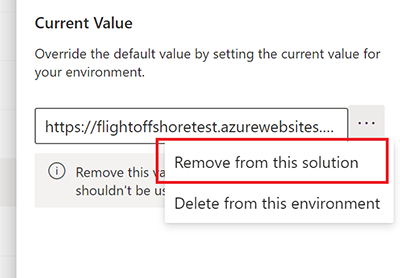Note
Access to this page requires authorization. You can try signing in or changing directories.
Access to this page requires authorization. You can try changing directories.
You can export and import agents using solutions so you can move your agents across multiple environments.
First, you create a custom solution and add your agent to it. Then you export the solution with your agent, and import it into another environment. You can also upgrade or update a solution with an agent, and remove an unmanaged layer from a managed agent.
See the article View and manage solutions in Copilot Studio for more details on the solution explorer in Copilot Studio.
Note
You can't export topic-level or node-level comments when you export an agent.
Prerequisites
- You must have at least the System Customizer security role to use this feature. Learn more about configuring user security in an environment.
- You should be familiar with solution concepts, as described in Solution concepts, and Create and manage solutions in Copilot Studio.
Things to know
You can't export topic-level or node-level comments when you export an agent.
Removing an agent from a solution doesn't remove its components from the solution. You should remove the components separately.
Warning
Don't remove unmanaged agents components, such as agent topics, directly from the solution unless you also remove the agent from the solution.
You should only make changes to topics as part of the standard authoring process in the Copilot Studio UI. Removing or changing an agent's components directly from the solution causes the export and import to fail.
You can't export managed solutions. When you create a solution, it's unmanaged by default. If you change it to a managed solution, you can't export it. You need to create a new solution.
It isn't possible to export a solution that contains an agent with periods (
.) in the name of any of its topics.
Create a custom solution and add your agent
Follow the steps in Create and manage solutions in Copilot Studio to create a new solution in the Copilot Studio solution explorer.
The solution you created should open automatically. If it doesn't, select it in the list of solutions.
Select Add existing, and then select Agent, then Agent again.
In the Add existing agents list, select the agent or agents you want to export, and then select Add.
Note
For a Classic chatbot:
If you're using skills, remove the skill's environment variable Current Value by selecting Remove from this solution.

Removing an agent from a solution doesn't remove its components from the solution. You must remove the components separately.
Add components to an agent in a custom solution
If you add components, such as topics or flows, to your agent in Copilot Studio, you must also add them to the agent in your unmanaged solution before you export.
Open the solution explorer in Copilot Studio.
Select the solution that contains your agent.
In the Objects pane, locate your agent under Agents.
Select the three dots (⋮), select Advanced, and then select Add required objects.
You should also review the instructions and requirements in the Power Apps documentation to add an existing component to a solution.
Export the solution with your agent
You export and import agents by exporting and importing the solutions that contain them from one environment to another.
To export the solution with your agent, follow these steps:
Open the solution explorer in Copilot Studio.
In the list of unmanaged solutions, select the solution that contains your agent.
Select Export solution. As in the Power Apps export solutions experience, the Before you export right pane appears.
The rest of the steps are the same as for exporting solutions in Power Apps. Follow the instructions and requirements in the Power Apps documentation to finish exporting the solution.
Important
If your agent has a large number of components (for example, more than 250 topics or more than 100 entities), see Export using the classic experience.
Import the solution with your agent
To import the solution with your agent into another environment, follow these steps:
In the target environment, open the solution explorer in Copilot Studio.
Select Import solution. As in the Power Apps import solutions experience, the Import a solution right pane appears.
The rest of the steps are the same as for importing solutions in Power Apps. Follow the instructions and requirements in the Power Apps documentation to finish importing the solution.
If the import isn't successful, select Download log file to download an XML file that contains details about what caused the import to fail. The most common reason an import fails is that the solution doesn't contain some required components.
In the solution explorer, select the new imported solution from the list.
In the Objects pane, select Agents. Then select the agent's name to open the agent in Copilot Studio in a new tab.
Configure user authentication for the agent again.
Important
- You must publish your imported agent before it can be shared.
- It might take up to 24 hours for your agent's icon to appear everywhere.
Export and import agents in Teams
In Microsoft Teams, you can export and import agents between individual teams using the Power Apps Teams app.
For example, if you export a working agents from a Teams team (team A), and then import it into team B, you don't have to build it from scratch for team B.
Follow the instructions in Export customizations from Dataverse for Teams.
When selecting the customizations to export, select the agent you want to export. You can use the filter on the side pane to only show agents for a specific team.
The agent is saved to the Downloads folder on your computer.
To import in Teams, follow the instructions in Import customizations into Dataverse for Teams.
Your agent appears in the Copilot Studio app in Teams, under the team you imported it into.